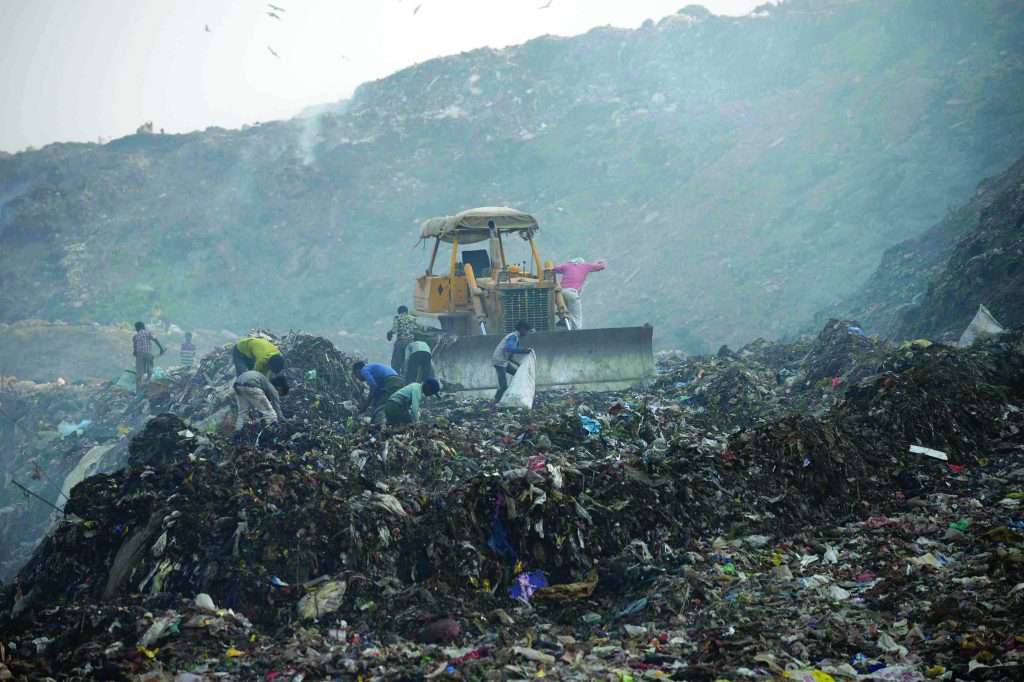Delhi’s Bhalswa landfill is undergoing a significant environmental makeover, with efforts in full swing to convert the 70-acre site into a green zone. Once a 62-meter-high garbage dump, which was almost like a small hill, the landfill is now witnessing a rapid cleanup, with the Municipal Corporation of Delhi (MCD) reclaiming five acres for plantation.
The green initiative, spearheaded by the new BJP-led Delhi government’s Chief Minister Rekha Gupta and Lieutenant Governor VK Saxena, aims to curb pollution and improve air quality in the region.
Bamboo has been chosen for the plantation drive due to its high oxygen production and low water requirements. So far, 2,000 bamboo saplings have been planted, with the target of 50,000 more in the coming months.
DELHI’S BATTLE AGAINST LANDFILL POLLUTIONS
Emphasising the importance of this initiative in reducing pollution, the L-G said, “We have resumed plantation after two years. In total, 54,000 bamboos will be planted to create a green patch here. This is a crucial step towards a pollution-free Delhi.”
The Bhalswa dump is an unsightly mountain of garbage on the city’s northern outskirts. It is one of the several overflowing landfills visible on Delhi’s skyline, with some as high as 60 meters (200 feet). According to official figures, the Bhalswa site has more than 4 million tonnes of waste.
Keeping with its poll promise to clean up the national capital, the newly formed government has vowed to clean up one of its largest trash piles by March 2026.
According to media reports, the efforts to clean up the site began in 2019 and the waste mountain’s height has significantly reduced in the first year by 11 to 12 meters.
However, the city simultaneously adds waste to the site as well. According to the latest estimates from 2023, Delhi generates more than 11,000 tonnes of solid waste each day.
NATURE’S STUDY ON DELHI POLLUTION
Delhi has been ranked the world’s most polluted capital for seven years in a row. A study published in Nature journal this year on 13 March shows air pollution in the capital is more severe than currently estimated because the ultrafine particulate pollutants (PM1) are being undercounted by up to 20%.
Fine particulate matter is one of the major pollutants in Delhi. It is also among the deadliest with severe health impacts.
The report states that the fine particulate matter is the most dominant pollutant in New Delhi and is estimated to be responsible for about 10,000 premature deaths per annum. The up-to-date World Health Organization (WHO) Ambient Air quality database reported the annual average of fine particulate matter mass concentration of 121 μg/m3 in New Delhi, which is 24 times higher than the suggested healthy level by the WHO air quality guideline.
The reported particulate matter concentration in New Delhi is breath-holding, however, we may still underestimate it. This is because hygroscopic growth of particulate matter (increase in particle size due to the absorption of water vapour) can effectively reduce its sampling efficiency and therefore lead to underestimate of its mass concentration. Hygroscopic growth leads to particle size swelling, resulting in a cut-off shift effect which reduces the collection efficiency of sampling inlets. This bias is inherent in particle sampling and commonly exists all over the world; and this bias is largely dependent on the water uptake ability of aerosol particles: the higher aerosol hygroscopicity the larger underestimation in mass concentration.


SIGNIFICANCE OF BAMBOO PLANTATION
Bamboo is one of the plants with the fastest growth rate (35-36 inches within 24 hours) and is widely distributed throughout India, especially in the Northeastern states. India is the second largest producer of bamboo and is yet to encash upon the full economic potential of this fastest growing land plant in the world.
The plantation of bamboo on one hand controls pollution; while on the other, it has significant economic benefits by means of ethanol production. The Delhi government in future can utilise bamboo plantation in ethanol production.
BAMBOO FOR POLLUTION CONTROL
Most of the major metropolitan cities of India like Delhi and Mumbai are in the grip of extreme pollution and are trying to adopt newer ways to clean the air surrounding them.
Growing bamboo within the city limits and outskirts will create areas of carbon sink and help in carbon sequestration during its growing years. It acts as a natural air cooler as it cools the temperature around it by nearly eight degrees. The bamboo plant is highly sustainable, has a high growth rate, doesn’t require replantation, and can be harvested quickly (within five years).
It provides a faster reduction rate of carbon footprint and produces nearly 30-35% more oxygen in comparison to an equivalent area of woody plants. Bamboo can be used as an excellent scavenger plant and can be planted along polluted rivers of India. Its roots reach a maximum of only two feet and therefore absorb nutrients from untreated
sewage and increase the biological oxygen demand of the water body. Same principle can be of great use in cleaning river Yamuna.
BAMBOO FOR OIL ECONOMY
Bamboo has a high cellulose content, making it possible to produce a large amount of ethanol from a small volume of bamboo. As a result, it serves as an economical and effective raw material for ethanol production. Bamboo-derived ethanol is non-toxic and biodegradable, making it environment friendly and safe for use.
Ethanol is a chemical solvent and a fuel source that has significant advantages including a higher Research Octane Number (RON) of the blend, fuel-embedded oxygen, and higher flame speed. As a result of all these factors, ethanol promotes complete combustion and lowers the vehicular emissions of poisonous gases like carbon monoxide and particulates, and improves air quality.
Adopting the use of ethanol-blended fuels such as E85 (85% ethanol and 15% gasoline) can greatly reduce the net emission of greenhouse gases. Exhaust gases of bamboo-based ethanol are much cleaner since it burns more clearly. The greenhouse gas emission is nearly 12% less in comparison to the production and combustion of polluted gases by the use of regular diesel.
CONCLUSION
By promoting the introduction of bamboo-extracted ethanol technology, India has put another step forward towards Atmanirbhar Bharat and also towards realising the goals of global climate resilience. It has got huge potential to be a game disruptor in the field of bioenergy by providing ethanol for blending at competitive prices and also by giving livelihood to scores of bamboo-growing farmers. The state governments have also realised the economic importance of bamboo and a tool to combat pollution, and have initiated various schemes for bamboo adoption.
Delhi too can get rid of pollution menace and subsequently contribute to its exchequer and significantly achieve Sustainable Development Goals (SDGs) for India through cultivation and use of bamboo. Out of the 17 SDGs, bamboo alone can help address nearly seven aims and achieve the ambitious targets.
*Prof Rajeev Singh is a professor of Chemistry at Atma Ram Sanatan Dharma College, University of Delhi, while Debobrat Ghose is the Editor of Science India.










